As the spring 2021 semester gets underway, college and university faculty, administrators, AV/IT managers, and instructors are on the offense and ready for any combination of in-class and remote learning that the year ahead might require.

There’s no escaping the fact that the COVID-19 pandemic has wreaked havoc, with so many suffering great heartache and loss, but some see a silver lining. Randy Tritz, a partner at Shen Milsom & Wilke and managing principal of SM&W Chicago, feels that the digital technology divide has been all but erased. “The predominance of synchronous instruction and learning is giving way to asynchronous learning on a global scale,” Tritz said.
Call it HyFlex, hybrid, remote, or distant, the blended learning environment will be the norm for 2021 and a trend that will most likely carry well into the future. “Technology deployment has taken a whole new meaning in terms of function and application. Planning a class space and curriculum now requires consideration of not only the in-person learner but also the remote learner,” Tritz said. The dynamic class session has become a focus of design trends for consultants and integrators. “The classroom has truly become a room without walls in more than one way, requiring learning environment design to take a much deeper dive into acoustics, lighting, space, and orientation,” he added.
Intuitive
With more technologies deployed and potentially fewer support staff available, hybrid and distance learning models drive home the need for a classroom interface that’s easy to use. “These intuitive controls focus on substantially improving the user experience by customizing the user interface for the instructor, without the complexity that was necessary just a year or two ago,” Tritz said.
[ The Critical Pivot from Classroom to Distance Learning ]
Unified communications planning in a classroom environment looks extensively at the user interface and the user experience. “This mandates reconsidering control, audio, and video systems as a single function rather than individual components that just happen to work together with significant integration,” Tritz added. “Voice, video, data, analytics, virtualization, and collaboration are being deployed using any platform, including cellular devices, tablets, laptops, etc. Gone are the days of specialized hardware for each aspect of communication.”

Critical Elements
Tritz emphasized the need for enhanced audio systems that allow natural-sounding conversations between local and remote students. “This requires a rethinking of many existing spaces that may have been designed primarily for presentation,” he said.

In addition to audio solutions, Paul Richards, director of marketing at PTZOptics and HuddleCamHD, identified document cameras, webcams, robotic tracking cameras, greenscreens or backdrops, digital displays, whiteboards, and lighting as elements that will remain necessary in the hybrid and distance learning classroom. “Going forward, the technology will no longer be an experiment for instructors but instead a reliable and predictable part of their overall online teaching strategy,” Richards said. “Technologies that ‘just work’ are generally certified for the web collaboration solutions deployed by schools.”
[ Distance Learning Technology Prepares Pepperdine University for Fall 2020 Semester ]
Richards sees a trend toward incorporating tools that enhance a collaborative experience but stressed the importance of keeping in mind what worked inside classrooms and lecture halls. “Videoconferencing platforms—in group and individual settings—will continue to be an important part of this virtual learning mission,” he said. “Teachers will use more recorded videos, apps for interactive quizzes, and work-sharing, while balancing that technology with structured breaks and personal communication.” A combination of asynchronous and synchronous classes allows for the immediacy of interaction and flexibility for students who need a more on-demand experience.
Flexibility

Vistacom has been installing permanent classroom technology solutions for decades; however, the company is now seeing greater demand for highly customized solutions that meet an institution’s unique hybrid learning requirements.
As the pandemic is not yet in the rearview mirror, there’s still a push for “no-contact” teaching. “Teachers want technology they don’t have to interact with physically but can still share/project their teachings,” said Paris Orrison, engineering manager at Vistacom. “We also see more remote technology classroom setups.”
Since the pandemic started last spring, Vistacom has installed portable cart systems, virtual learning classrooms, hybrid classrooms, studios and podcast suites, and Learning Glass installations. “While extensive hardware was previously required for classrooms, now it’s just a simple application. But with the pandemic still evolving, we’re seeing increasing adoption of technology that doesn’t lock educational institutions into using these applications indefinitely,” Orrison said. “Administrators want technology that can be used when needed and set aside when not.”
One of the most important lessons Vistacom has learned from working with higher ed institutions, specifically with distance learning applications, is that there is no one-size-fits-all solution. “Due to classroom setups, videoconferencing preferences, teaching styles, and hybrid scenarios, each technology solution designed and installed by Vistacom has been highly customized and tailored to the unique needs of the institution, and even the unique needs of specific departments within the university,” added Orrison. “This has allowed our higher ed clients to adopt a technology workflow that makes sense for how they teach and present—also leading to enhanced user adoption by faculty.”
The Studio
“Many schools are taking small conference rooms and turning them into mini video production studios,” added PTZOptics’ Richards. Pennsylvania State University developed the One Button Studio, a simplified video recording setup that can be used by those without video production experience. “However, with the right tools, much of this can be achieved in a home-based setting,” Richards said.
During the past year, several universities have created studios that allow instructors to teach a class within an environment that offers proper lighting, acoustics, cameras, microphones, and a full complement of tools that may not be readily available elsewhere. “However simple it may be, it provides a common space with access to the tools necessary to develop content,” SM&W’s Tritz said. These studios also offer live face-to-face time without in-person contact.
Vistacom has been installing Learning Glass studios, where teachers can walk in and record a lesson that is either streamed live or can be played back on-demand by students. “The Learning Glass has become popular among education institutions because of its unique setup that allows professors to write and demonstrate their lesson on a glass board without having to turn their back to students or the camera,” Orrison said. Learning Glass technology flips writing on the board so it’s not backward for viewers, making everything readable by the camera and recording software.
Also becoming more common are recording studios in which professors can walk in, plug in a thumb drive, press a button, and record a lesson, all without interacting with a production crew. “This ‘one-button’ recording studio is growing in popularity because it’s already set up. When they’re done, the user simply sanitizes that one button,” Orrison said. “We are also installing podcast suites where teachers can record a lesson with high-quality audio for students.”

